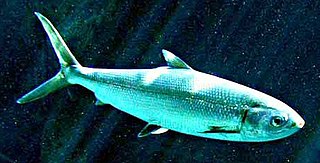
The Gonorynchiformes are an order of ray-finned fish that includes the important food source, the milkfish, and a number of lesser-known types, both marine and freshwater.

Chanidae is a family of fishes which has a number of fossil genera and one monotypic extant genus which contains the milkfish.
Amazonsaurus is a genus of diplodocoid sauropod dinosaur from the Early Cretaceous Period of what is now South America. It would have been a large-bodied quadrupedal herbivore with a long neck and whiplash tail. Although more derived diplodocoids were some of the longest animals ever to exist, Amazonsaurus was probably not more than 12 meters (40 ft) long. Gregory S. Paul estimated in 2010 its weight at 5000 kg.

Cristatusaurus is a genus of theropod dinosaur that lived during the Early Cretaceous Period of what is now Niger, 112 million years ago. It was a baryonychine member of the Spinosauridae, a group of large bipedal carnivores with well-built forelimbs and elongated, crocodile-like skulls. The type species Cristatusaurus lapparenti was named in 1998 by scientists Philippe Taquet and Dale Russell, on the basis of jaw bones and some vertebrae. Two claw fossils were also later assigned to Cristatusaurus. The animal's generic name, which means "crested reptile", alludes to a sagittal crest on top of its snout; while the specific name is in honor of the French paleontologist Albert-Félix de Lapparent. Cristatusaurus is known from the Albian to Aptian Elrhaz Formation, where it would have coexisted with sauropod and iguanodontian dinosaurs, other theropods, and various crocodylomorphs.

Lycoptera is an extinct genus of fish that lived from Lower Cretaceous, Barremian to Aptian in present-day China, North Korea, Mongolia and Siberia. Although there is record from Jurassic Formation in Siberia, its age remains questionable. It is known from abundant fossils representing sixteen species, which serve as important index fossil used to date geologic formations in China. Along with the genus Peipiaosteus, Lycoptera has been considered a defining member of the Jehol Biota, a prehistoric ecosystem famous for its feathered dinosaurs, which flourished for 20 million years during the Early Cretaceous, where it occurs abundantly in often monospecific beds, where they are thought to have died in seasonal mass death events. Lycoptera is a crown group teleost belonging to an early diverging lineage of the Osteoglossomorpha, which contains living mooneyes, arapaima, arowana, elephantfish and knifefish/featherbacks.

Axelrodichthys is an extinct genus of mawsoniid coelacanth from the Cretaceous of Africa, North and South America, and Europe. Several species are known, the remains of which were discovered in the Lower Cretaceous (Aptian-Albian) of Brazil, North Africa, and possibly Mexico, as well as in the Upper Cretaceous of Morocco (Cenomanian), Madagascar and France. The Axelrodichthys of the Lower Cretaceous frequented both brackish and coastal marine waters while the most recent species lived exclusively in fresh waters. The French specimens are the last known fresh water coelacanths. Most of the species of this genus reached 1 metre to 2 metres in length. Axelrodichthys was named in 1986 by John G. Maisey in honor of the American ichthyologist Herbert R. Axelrod.

Mawsonia is an extinct genus of prehistoric coelacanth fish. It is amongst the largest of all coelacanths, with one quadrate specimen possibly belonging to an individual measuring 5.3 metres in length. It lived in freshwater and brackish environments from the late Jurassic to the mid-Cretaceous of South America, eastern North America, and Africa. Mawsonia was first described by British paleontologist Arthur Smith Woodward in 1907.
Santanichthys diasii is a species of extinct fish that existed around 115 million years ago during the Albian age. S. diasii is regarded as the basal-most characiform, and is the earliest known member of Otophysi. It appears as a small fish, similar in appearance to a modern-day herring little more than 30 millimeters in length. Its most striking characteristic is the presence of a Weberian apparatus, which makes it the most primitive known member of the order Characiformes, the order in which modern-day tetras are classified. Santanichthys has been unearthed from numerous locations throughout Brazil, in rocks dating to the Cretaceous Period. Its presence in these strata is seen as an indicator for the biogeography and evolution of its order.
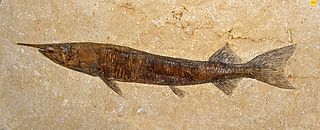
Vinctifer is an extinct genus of prehistoric bony fish erected by David Starr Jordan in 1919.

Tharrhias is an extinct genus of prehistoric bony fish that lived during the Aptian stage of the Early Cretaceous epoch. The type species T. araripis is named after the Araripe Basin, in which it was found in sediments of the Santana Formation.
Chanopsis is an extinct genus of prehistoric bony fish that lived during the Aptian stage of the Early Cretaceous epoch.

Araripichthys is an extinct genus of marine ray-finned fish that lived from the Aptian to Coniacian stages of the Cretaceous period. The genus is named after the Araripe Basin, where it was found in the Crato and Santana Formations. Other fossils of the genus have been found at Goulmima in Morocco, the Tlayua Formation of Mexico and the Apón Formation of Venezuela.
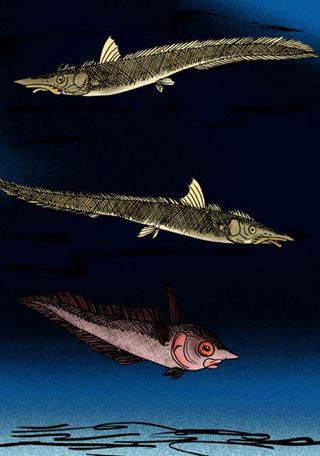
Laytonia is an extinct genus of prehistoric halosaur that lived in deep water off the North American Pacific Coast from the Zemorrian Epoch until during the Upper Miocene subepoch, when tectonic uplift effectively destroyed the genus' habitat by making the deep water too shallow.
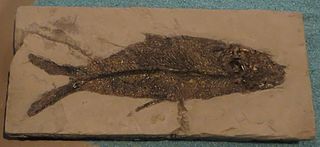
Aethalionopsis is an extinct genus of prehistoric freshwater bony fish from the Early Cretaceous of western Europe. Formerly classified as a species of the elopiform Anaethalion, it is now known to be a relative of the modern milkfish (Chanos) in order Gonorhynchiformes. It was previously placed as a basal member of the suborder Chanoidei, but is now more often placed as a basal member of the subfamily Chaninae of the family Chanidae, placing it closer to the extant Chanos.
Casieroides is an extinct genus of prehistoric freshwater ray-finned fish. It contains a single species, C. yamangaensis from the Early Cretaceous Loia Formation of the Democratic Republic of the Congo.
Caeus is an extinct genus of prehistoric marine ray-finned fish, closely related to the modern milkfish. It contains a single species, C. leopoldi from the Early Cretaceous of the Pietraroja Plattenkalk, Italy. It is one of the largest teleosts known from the Pietraroja formation, and is known by only a single specimen.
Cylindracanthus is an extinct genus of Cretaceous to Eocene aged ray-finned fish. It is almost exclusively known from bony rostrum fragments as well as some associated teeth, with the rest of the skeleton being cartilaginous. While originally considered to be closely related to billfish, the structure of its rostrum is dissimilar, and is unlikely to be closely related, some later studies suggested closer affinities to the Acipenseriformes. However, this was later rejected due to the lack of osteocytes in histologically examined specimens, which resembles the condition of derived teleosts. A close relation to Blochius has been suggested.
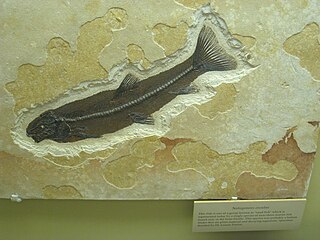
Notogoneus is an extinct genus of prehistoric ray-finned fish. A trace fossil attributed to Notogoneus osculus has been found in the Green River Formation.

Chresmoda is an extinct genus of insects within the family Chresmodidae.

Makarkinia is an extinct genus of lacewings in the family Kalligrammatidae described by Martins-Neto in 1997 from fossils found in the Crato Formation of the Araripe Basin in northeastern Brazil. The genus contains three species dating to the Late Aptian, Makarkinia adamsi, Makarkinia kerneri and Makarkinia irmae.













